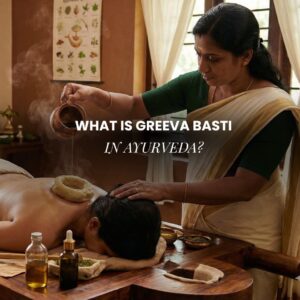Panchakarma Detoxification in Ayurveda is a comprehensive purification process designed to cleanse the body of accumulated toxins (Ama) and restore its natural balance. Rooted in ancient Ayurvedic principles, Panchakarma consists of five therapeutic procedures, that includes Vamana (therapeutic vomiting), Virechana (purgation), Basti (medicated enema), Nasya (nasal administration), and Raktamokshana (bloodletting). Also, these Panchakarma detoxification treatments are based on each individual’s unique constitution (Prakriti) and health issues to detoxify and heal.

The process begins with Purva Karma (preparatory phase) that softens and mobilizes toxins. Following the initial Panchakarma detoxification treatment, the main treatments begin, which is called Pradhan Karma. Once this detoxification therapy is complete, the body can resume its natural functioning without interference. However, post procedure is an essential and mandatory healing step. To summarize the Panchakarma procedure contains three steps:
- Purva Karma – Pre-Procedure
- Pradhan Karma – Actual Procedure
- Paschat Karma – Post Procedure
Purva Karma
Preparations which have to be done before the detoxification are known as Purva Karma that includes:
- Deepana and Pachana
- Snehana
- Swedana
Deepana & Pachana (Enhancing the Digestive Fire): These steps are adopted to cleanse the channels so that the toxins are detached and eliminated easily during the main detoxifying process.
Snehana (Oleation Therapy): After Deepena & Pachana whole body is oleated with Snehapana (oral) and Abhyanga (massage) with medicated oil or ghee which disintegrates the accumulation of vitiated Doshas (toxins or waste).

Swedana (Hot Fomentation): Swedana is the process of inducing sweat with the help of steam, made from medicated herbal decoctions. It is to dilate the channels of the body to detach the vitiated Doshas (toxins or waste) from the tissues.
Pradhan Karma
It is the main Panchakarma detoxification process that is the main treatment of curing a particular ailment.
- Vamana (Therapeutic Emesis)
- Virechana (Therapeutic Purgation)
- Basti (Decoction Enema)
- Nasya (Instillation of Medicine through Nostrils)
- Raktamokshan (Bloodletting)
Vamana Karma (Therapeutic Emesis): The process of expelling vitiated Doshas (toxins or waste) through the mouth by Vomit-inducing herbs is called Vamana Karma. Further, it is mainly indicated in vitiated Kapha and Kapha-Pitta Dosha disorders.
Virechana Karma (Therapeutic Purgation): The process of expelling vitiated doshas (toxins or waste) through the rectum by purgative herb is called Virechana Karma. Also, it is indicated in cleansing the body from excess Pitta-Kapha accumulation in the body.
Basti (Medicated Enema): In Basti, medicated oil or herbal decoction is administered through the anal route. It is the best treatment modality for all types of Vata Dosha disorders.
Nasya (Instillation of Medicine through Nostrils): The administration of medications via the nasal passages is called Nasya. The nasal cavity is the door to consciousness and the gateway to our brain. Hence, medicated oil, ghee, or smoke that is administered via the nasal passages affects the mind.
Raktamokshan (bloodletting): It is the procedure of expelling out the vitiated blood from the body to reduce the quantity of toxic substances. The bloodletting procedure is a kind of para surgery used especially for the treatment of Raktadusti (blood-borne disorders) and Pitta Dosha diseases.
Pashchat Karma
Pashchat Karma refers to the post-detoxification phase in Ayurveda, which is crucial for cementing the benefits of the Panchakarma treatment. After the body has undergone thorough detoxification, it is necessary to follow specific dietary and lifestyle changes to maintain its effects. Additionally, this phase includes a gradual return to regular activities, and lifestyle modifications to sustain the newly restored balance.
Benefits of Panchakarma Detoxification Treatment
- Removes accumulated toxins (Ama) from the body.
- Restores the natural balance of doshas (Vata, Pitta, Kapha).
- Enhances digestion and metabolic processes.
- Improves immunity and strengthens the body’s defense mechanisms.
- Promotes mental clarity and emotional well-being.
- Alleviates chronic conditions and disease symptoms.
- Rejuvenates and revitalizes the body, mind, and spirit.
- Helps in weight management and reduction of excess fat.
- Reduces stress and promotes relaxation.
- Improves skin health and complexion.
- Prevents the onset of future diseases and health issues.
- Enhances the effectiveness of other Ayurvedic treatments.
Diseases Curable from Panchakarma Treatment
The list of ailments that can be cured from Panchakarma detoxification process are:
- Early-stage digestive disorders (e.g., indigestion, acid reflux)
- Certain skin conditions (e.g., eczema, psoriasis, acne) with early intervention
- Mild to moderate obesity and metabolic issues
- Certain types of allergies (e.g., seasonal allergies) with a follow-up
- Chronic headaches and migraines episodes
- Joint pain in early stages (e.g., mild arthritis, joint stiffness)
- Early-stage respiratory health problems (e.g., sinusitis, mild asthma)
- Mild to moderate anxiety and stress-related psychological disorders
- Certain gynecological disorders (e.g., menstrual irregularities)
While Panchakarma is known to offer a significant relief to many health conditions, however, a complete cure depends on factors like the stage of the disease, individual constitution, and follow to post-treatment guidelines. Further, it’s essential to consult with an Ayurvedic doctor for a complete assessment.
Vaidyaratnam Vrindavan Ayurveda Chikitsalayam: Ayurveda Hospital Near Chandigarh
At Vaidyaratnam, Vrindavan Ayurveda Chikitsalayam is one of the best Ayurveda hospitals near Chandigarh. At VVAC, we offer classical and authentic Panchakarma detoxification treatment straight from Kerala. Additionally, we plan a customized Panchakarma treatment for every specific ailment to their Prakriti (Body Type), under a specialized physician.
The hospital is surrounded by lush greenery and helps you experience a moment of silence, that elevates you to a balanced and sublime state of mind.
Further, the green stretch and comfortable accommodation of the hospital with traditional architecture, Gaushala and temples combines a touch of heritage with nature.





